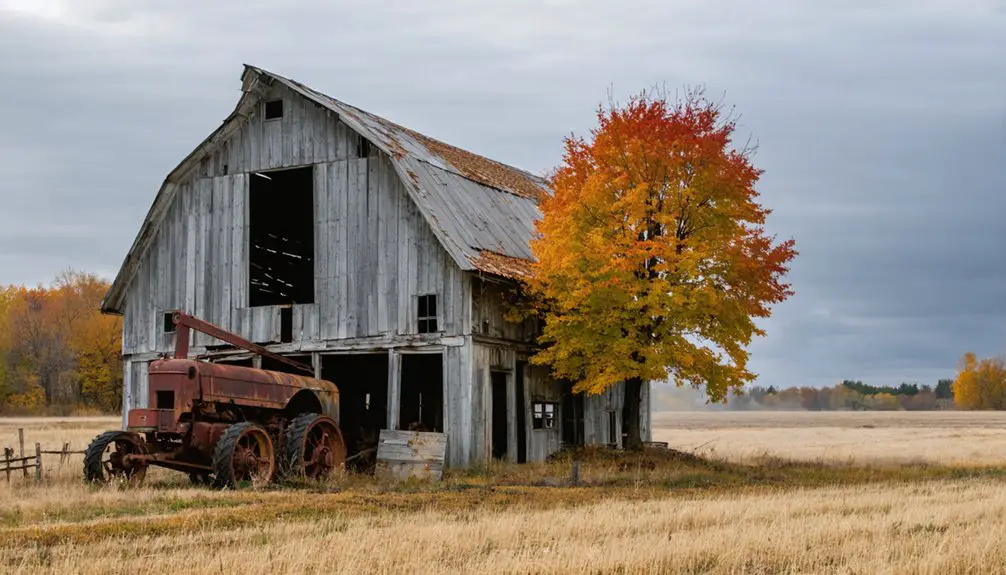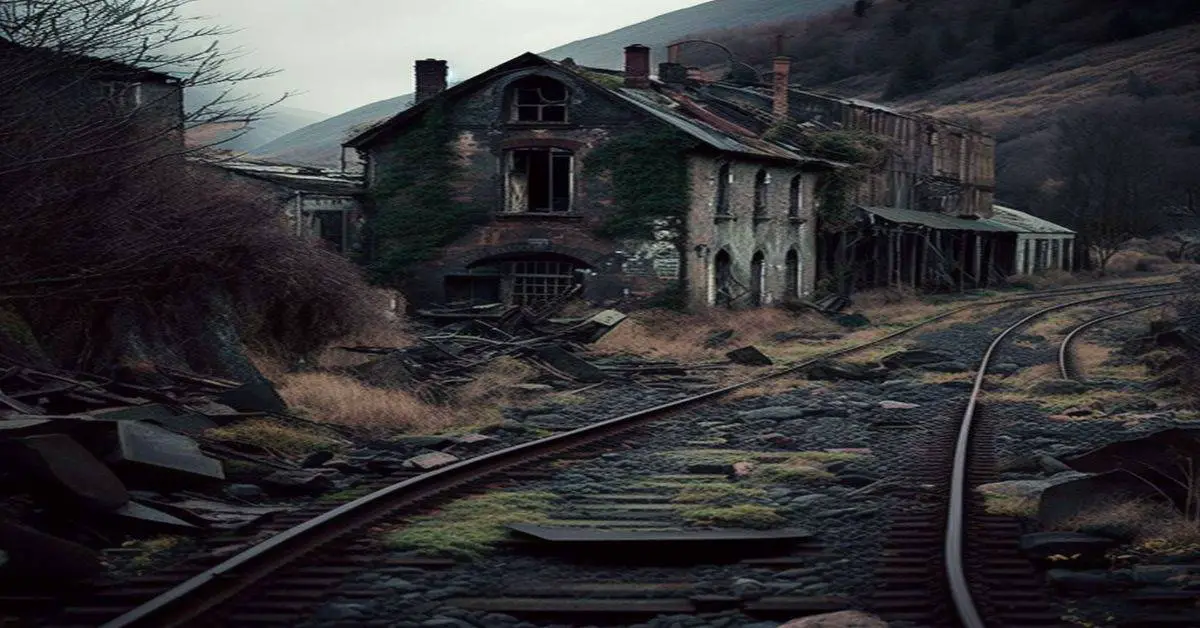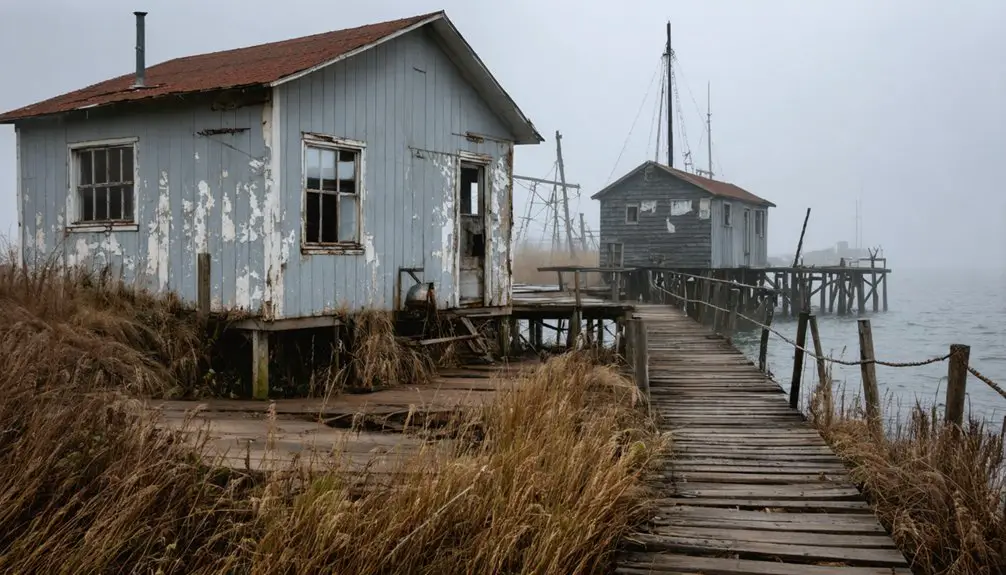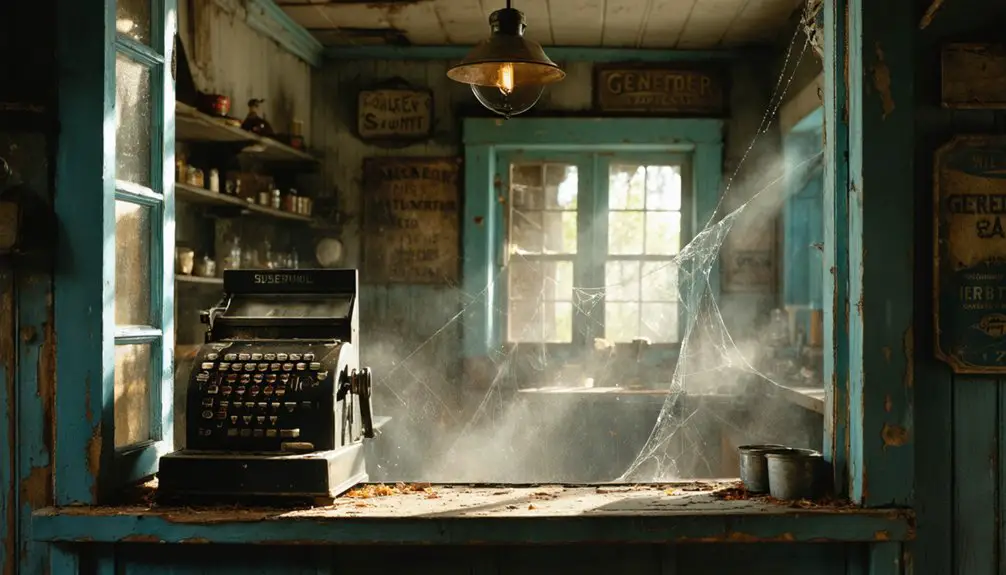You’ll find Kaiser’s ghost town remnants along Wisconsin’s Tuscobia State Trail, where this once-thriving logging settlement showcases the boom-and-bust cycle of early 20th-century timber towns. Founded in 1901, Kaiser grew around J.S. Kaiser’s sawmill and the Omaha railway terminal, shipping 20 railroad cars of lumber daily at its peak. Today, nature has reclaimed the site, but its foundation traces and artifacts tell a compelling story of northern Wisconsin’s logging heritage.
Key Takeaways
- Kaiser was established in 1901 as a logging community five miles west of Park Falls along the Tuscobia State Trail.
- The town thrived around J.S. Kaiser’s sawmill, which controlled 38,000 acres and produced 20 railroad cars of lumber daily.
- Economic decline began when railroad infrastructure changed in 1911, isolating Kaiser from major markets.
- The depletion of timber resources and closure of rail connections led to the town’s eventual abandonment.
- Today, Kaiser exists only as foundational remnants along the Tuscobia State Trail, largely reclaimed by surrounding forests.
Early Settlement and Founding
While many Wisconsin towns emerged from the logging boom of the late 1800s, Kaiser’s story began in 1901 when a certified logger from nearby Park Falls established this settlement in Price County.
Kaiser stands as another testament to Wisconsin’s logging heritage, born in 1901 from a Park Falls logger’s pioneering spirit.
You’ll find Kaiser’s roots actually stretch back to 1881, when early settlers first discovered the area’s rich timber potential. The town took shape along what you’d now recognize as the Tuscobia State Trail, about five miles west of Park Falls. Like the German emperors before it, the town’s name Kaiser represented authority and leadership in the region.
The founding families wasted no time building their community. By 1901, they’d established a post office and general store to serve the growing population. The area became an important Omaha railway terminal until 1913.
When J.S. Blackwell constructed a sawmill in 1905, it drew more workers and their families, transforming Kaiser from a simple logging camp into a proper settlement.
Life in Kaiser’s Heyday
During Kaiser’s peak years following 1905, life revolved around the rhythmic hum of J.S. Kaiser’s sawmill, where you’d find most of the town’s residents earning their living.
You would’ve witnessed the tight-knit community embracing logging traditions, from seasonal timber harvests to the daily bustle of mill work. The town’s European settlers, mostly working families, created a resilient social fabric despite their transient nature. Like many towns of the era, Kaiser’s fate was sealed when railroad routes bypassed the settlement.
After a hard day’s work, you might’ve found yourself at one of the local gathering spots – perhaps a general store or community hall where neighbors shared stories and celebrated seasonal milestones. Today’s treasure hunters often discover buried artifacts from this era while metal detecting in the area.
While amenities were basic, with simple worker housing and rudimentary transportation along early rail and wagon trails, the community’s spirit remained strong, adapting to northern Wisconsin’s harsh conditions and the demanding lifestyle of a logging town.
The Rise of the Mill Industry
As J.S. Kaiser established his lumber company in 1905, you’d have witnessed the birth of Eau Claire’s last major lumber operation. His strategic positioning near Half Moon Lake and command of nearly 38,000 acres of timber rights set the stage for remarkable economic growth.
Kaiser’s lumber empire marked Eau Claire’s final chapter in the timber trade, strategically dominating 38,000 acres near Half Moon Lake.
While unrelated to Kaiser Aluminum Corporation, which would later become a major player in metals manufacturing, the Kaiser lumber operation represented a different industrial era.
You would’ve seen 20 railroad cars of lumber rolling out daily by 1911, showcasing the operation’s impressive scale.
The business wasn’t just about raw lumber – you’d have found a complete woodworking ecosystem with sawmills, box factories, and planing mills.
After acquiring Daniel Shaw Lumber Company in 1913, Kaiser’s workforce swelled to 350 employees, churning out up to 175,000 board feet daily.
The company’s box factory operations became their primary focus by 1917, supplying packaging materials to major meat packing houses across the region.
This vertically integrated powerhouse exemplified how the lumber industry transformed Wisconsin’s landscape and economy until its eventual closure in 1939.
Railroad’s Role in Kaiser’s Development
The Wisconsin Central Railroad‘s expansion into northern Wisconsin in the early 1870s laid the groundwork for Kaiser’s meteoric rise in the lumber industry.
Despite the Panic of 1873 causing major financial setbacks, the railroad eventually recovered and continued its vital role in timber transport.
With strategic rail lines connecting Ashland, St. Paul, and Chicago, Kaiser’s vast timber holdings gained access to lucrative markets far beyond the region.
Similar to how Kaiser Steel built massive infrastructure for BART years later, the company demonstrated expertise in large-scale industrial projects.
You’ll find that railroad logistics played an essential role in Kaiser Lumber Company’s success, as they shipped an impressive 20 railroad cars of lumber daily by 1911.
The company’s 37,900 acres of timber required efficient transportation networks, and the railroad delivered.
When Kaiser acquired the Daniel Shaw Lumber Company in 1913, their daily output soared to 175,000 board feet, showcasing how critical timber transportation had become to the town’s prosperity.
Daily Life and Community
Life in Kaiser revolved around the demanding rhythms of a bustling lumber town, where you’d find a tight-knit community of workers and their families adapting to the rugged northern Wisconsin wilderness.
The logging culture shaped every aspect of daily existence, from the dirt roads you’d traverse to reach the company store to the simple dwellings you’d call home.
You’d find comfort in community events at the local dance halls and bars, where lumberjacks gathered after long days in the forest.
The town’s buildings reflected its immigrant heritage, with Norwegian, German, and Swedish influences evident in both architecture and customs.
Folk beliefs ran deep – you might notice protective charms above doorways or salt scattered across thresholds, silent testimony to the supernatural fears that gripped this remote settlement. Like nearby Black River Falls, the town experienced dark misfortunes that led many residents to believe the area was cursed. The abrupt end of the timber boom devastated the community, leaving families struggling to survive as jobs vanished and poverty set in.
Economic Challenges and Decline
You’d recognize Kaiser’s economic downfall from two major blows: the depletion of its precious timber resources and devastating changes to its railroad connectivity.
The town’s sawmill operations, which had attracted workers and spurred growth in the early 1900s, couldn’t sustain themselves as logging declined and nearby forests thinned out.
When the Omaha railway line extended past Kaiser after just three years, removing the town’s status as a terminal, you could see how quickly a small Wisconsin community could unravel without reliable transportation for its dwindling timber products.
Resource Depletion Impact
Relying heavily on local natural resources, Kaiser’s economy flourished initially through mining and timber extraction but couldn’t sustain its rapid growth.
As resources depleted, the town’s prosperity began to crumble. You would’ve seen businesses closing their doors and workers leaving in search of new opportunities elsewhere.
The rapid resource extraction that once brought wealth to Kaiser ultimately sealed its fate.
Without economic shift plans or industry diversification, the town couldn’t adapt when its natural resources ran dry.
You can still find remnants of Kaiser’s resource-dependent past in abandoned mining equipment and overgrown timber mills.
The town’s story serves as a stark reminder of how overreliance on a single industry, combined with unsustainable practices, can transform a thriving community into a ghost town.
Railroad Changes Devastate Town
While resource depletion dealt Kaiser its first major blow, changes to the railroad system would deliver an even more devastating impact.
You can trace Kaiser’s downfall to 1911, when the C&NW railroad built a more direct mainline north of the Wisconsin River, bypassing the town completely. The resulting shift in railroad infrastructure stripped Kaiser of its crucial transportation artery, leading to profound economic isolation.
As railroad operations moved to Madison and service dwindled, you’d have witnessed the town’s lifeblood slowly drain away.
The closure of railroad shops, elimination of passenger service by 1963, and eventual track abandonment west of Reedsburg in the 1980s left Kaiser cut off from major markets. Without reliable rail connections for shipping goods or transporting people, the town’s remaining businesses and residents faced an impossible struggle to survive.
The Last Days of Kaiser
As the economic winds shifted in the late 20th century, Kaiser’s once-thriving mining community began its gradual descent into abandonment.
Economic forces transformed Kaiser from a vibrant mining hub into a fading memory of its industrial past.
You’d have witnessed the harsh reality of dwindling iron ore demand and mounting environmental pressures that forced the mines to first reduce operations, then shut down completely. This mining history ended not with a bang, but with a slow fade.
One by one, you’d have seen the town’s lifelines severed – the grocery store closing its doors, the post office shuttering after 31 years, and families moving away in search of new opportunities.
What remained was a ghost town’s skeleton: empty homes, silent schools, and abandoned recreational spaces.
Today, you’ll find the Tuscobia State Trail winding through where Kaiser’s streets once bustled with life, marking the final chapter of this Wisconsin mining community.
Present-Day Site and Remnants
Today in Price County, you’ll find Kaiser’s ghost town remnants quietly nestled along the Tuscobia State Trail, roughly 5 miles west-southwest of Park Falls.
At an elevation of 1,499 feet, the former settlement has largely returned to its natural landscape, with the surrounding forests reclaiming what was once a bustling logging community.
You won’t see any standing structures from Kaiser’s heyday – time has erased most visible traces of the town.
While foundational remnants might lie beneath the surface, they’re difficult to spot among the vegetation.
The site’s main access point is now the Tuscobia State Trail, following the old railroad corridor that once served as Kaiser’s lifeline.
While no formal historical markers guide your way, you’re free to explore this piece of Wisconsin’s logging heritage on foot or bike.
Legacy and Historical Significance
If you’ve ever explored Wisconsin’s ghost towns, you’ll find Kaiser’s story represents a classic example of how railroad terminals and lumber industries shaped early settlement patterns in the state’s northern regions.
The town’s brief but impactful existence as a railroad terminus and logging center mirrors the broader industrial heritage of Price County, where communities rose and fell with the fortunes of single industries.
Kaiser’s transformation from a bustling lumber town to an abandoned settlement offers valuable insights into how transportation networks and economic changes reshaped Wisconsin’s rural landscape in the early 20th century.
Railroad Town Evolution
The rise and fall of Kaiser, Wisconsin tells a compelling story of how railroad infrastructure shaped the destiny of early 20th-century lumber towns.
You’ll find Kaiser’s golden age perfectly captured in 1911-1913, when railroad expansion enabled the shipping of twenty rail cars daily, moving up to 175,000 feet of lumber. The Omaha Railroad Company’s line transformed this small settlement into a bustling hub of lumber transportation.
But like many railroad towns of its era, Kaiser’s fortunes were inextricably tied to the rails. When lumber operations dwindled and rail traffic decreased, the town’s liveliness faded.
Industrial Heritage Impact
Looking beyond Kaiser’s railroad legacy reveals a deeper story of industrial heritage that resonates throughout Price County.
You’ll find a cautionary tale of resource management in this former logging town, where Arnold E. Kaiser’s vision of industrial prosperity ultimately succumbed to depletion of the area’s timber resources. The town’s rise and fall mirrors the broader pattern of industrial decline that shaped northern Wisconsin’s landscape.
When you explore Kaiser today, you’re walking through living evidence of how single-industry communities transformed the region.
The remnants of logging operations, visible in old transport routes and altered forests, tell a powerful story of boom-and-bust economics. Kaiser’s experience continues to influence modern conversations about sustainable development and responsible resource use in Wisconsin’s rural communities.
Early Wisconsin Settlement
Centuries before Kaiser’s industrial rise and fall, Wisconsin’s settlement story began with indigenous peoples who masterfully shaped the region’s character through advanced agricultural practices and extensive trade networks.
You can trace their legacy through the intricate relationships they developed with the land, cultivating the “three sisters” – corn, beans, and squash – while maintaining vibrant trade connections stretching from the Great Lakes to the Gulf of Mexico.
- Ancient burial mounds still dot the landscape, reminding you of the deep spiritual connection indigenous peoples maintained with the land.
- Trade routes you travel today often follow paths first established by Native Americans thousands of years ago.
- The rich soil that drew settlers to Wisconsin was carefully tended by generations of indigenous farmers who understood sustainable agriculture.
Visiting the Former Town Site
Located approximately 5 miles west-southwest of Park Falls, Kaiser’s former town site can be accessed via the Tuscobia State Trail, which follows the historic Omaha railway grade.
For your ghost town exploration, you’ll find the site at an elevation of 1,499 feet, where nature has reclaimed most of the former settlement. You can reach the area by hiking, biking, or snowmobiling the trail.
Proper visitor preparation is essential since there aren’t any facilities or markers at the site. You’ll discover scattered building foundations and traces of railroad infrastructure among the vegetation.
Pack supplies, bring maps, and watch for uneven terrain. While exploring, you might spot the former sawmill location, which played a significant role in Kaiser’s early development before the town’s decline.
Frequently Asked Questions
Were There Any Notable Crimes or Incidents Reported in Kaiser?
You’d expect mystery murders and dark criminal history from a ghost town, but Kaiser’s records show no notable crimes or incidents – just a peaceful logging community that faded with time.
What Was the Peak Population of Kaiser During Its Most Prosperous Years?
You’re looking at around 4,000 residents during the boom years, when Kaiser’s economy thrived with logging and rail activity, though this number declined sharply once the railroad terminus moved elsewhere.
Did Kaiser Have Its Own School System or Church Buildings?
You’ll find a basic school existed by 1901, serving local families, but there’s no evidence of dedicated church buildings. The town’s brief life meant religious services likely happened in nearby communities.
What Specific Types of Trees Were Harvested in the Kaiser Area?
You’d find extensive pine harvesting focused on white and Norway pine initially, followed by jack pine and mixed hardwoods like maple, birch, and oak as the lumber industry evolved over time.
Were There Any Natural Disasters That Affected Kaiser’s Development?
You’d think harsh storms or raging fires shaped Kaiser’s fate, but there’s no evidence of major natural disasters. Economic shifts and railroad changes, not environmental impacts, determined the town’s destiny.
References
- https://en.wikipedia.org/wiki/Kaiser
- https://lakecountrytribune.com/exploring-the-haunting-echoes-of-wisconsins-ghost-towns/
- https://upnorthnewswi.com/2024/02/21/the-fascinating-stories-behind-7-wisconsin-ghost-towns/
- https://sites.rootsweb.com/~wiprice/kaiser.html
- http://freepages.rootsweb.com/~gtusa/history/usa/wi.htm
- https://raregoldnuggets.com/?p=3963
- https://www.youtube.com/watch?v=4abnhupnLac
- https://pbswisconsin.org/news-item/southern-wisconsins-ghost-towns-leave-behind-vital-stories/
- http://shunpikingtoheaven.blogspot.com/2016/05/a-wisconsin-ghost-town.html
- https://www.silverrecyclers.com/blog/metal-detecting-in-wisconsin.aspx



